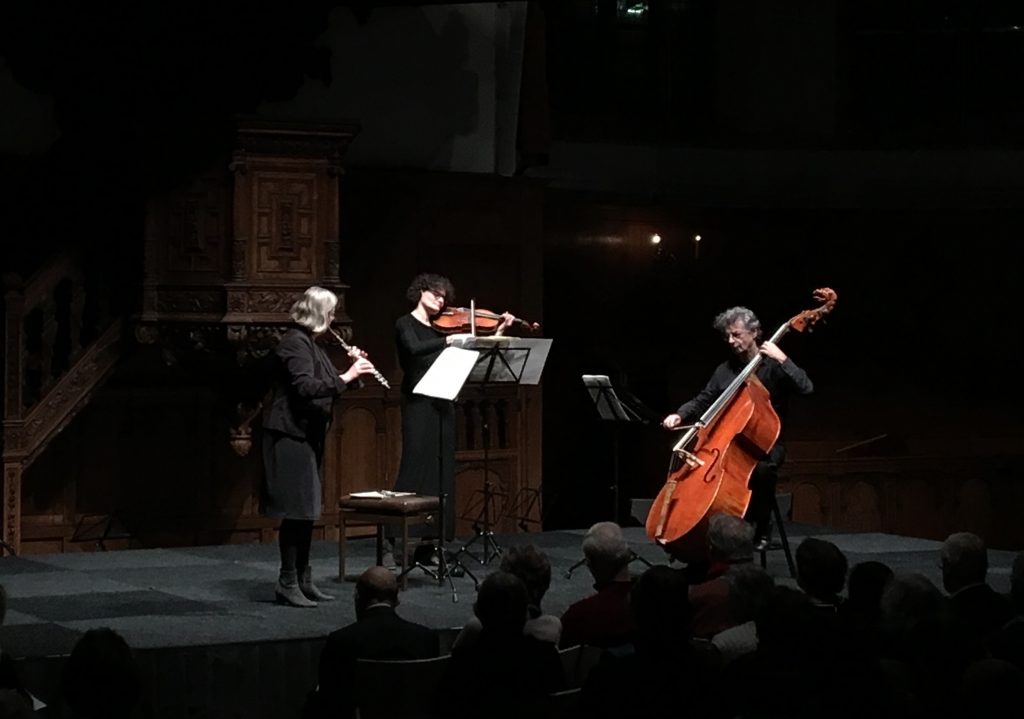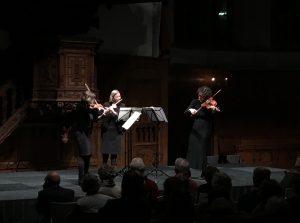Gehoord in Nieuwe Kerk Den Haag,
22 februari 2017
door Kristofer G. Skaug
English version below! Follow this link.
Het Residentie Orkest heeft een zwak voor altviolen. Vanavond mocht altvioliste Tanja Trede een programma ontwerpen met haar favoriete kamermuziek, waarin zij wordt bijgestaan door haar collega’s uit het orkest: Dorine Schade (fluit), Mara Oosterbaan en Cato Went (violen), Elisabeth Runge (altviool), Mileva Fialova en Roger Regter (cello), en Harry Donders (contrabas). Dat resulteerde in een heel bijzondere avond met de Tscjechische componist Ervin Schulfhoff in de hoofdrol.
Niet alleen was Schulhoff joods, entartete componist en fanatieke communist (“Absolute kunst is revolutie“); maar hij maakte het in de ogen van de Nazis helemaal bont door een staatsburgerschap van de Sovjet-Unie aan te vragen. In 1942 is hij in een concentratiekamp overleden, precies 75 jaar geleden dus.
Maar even terug naar het begin: Dvorak stond aan de wieg van de muzikale carriere van Schulhoff, daarom lijkt het logisch om het programma te laten beginnen met het Terzetto van Dvorak. Het is een leuk muziekje, maar vanavond kan het mij niet echt meeslepen.
Het Concertino van Schulhoff (voor piccolo/dwarsfluit, altviool en contrabas) daarentegen boeit vanaf de eerste maat. De enorme spanwijdte in toonhoogte, van de hoogste piccolonoten tot de diepste bas-snaar, zorgt voor een merkwaardig gevoel dat er zich rondom de middenstem (altviool) nog meer muzikale schijn-stemmen.roeren. Want het blijft bij 3 fysieke instrumenten en stemmen. Het volksdansje in het afsluitende “Allegro gaio” blijft lekker in mijn hoofd hangen.
We blijven nog even in trio-bezetting, nu voor de Serenade op.141a van Max Reger (die ook een leraar was van Schulhoff): fluit, viool en altviool. Het begint met een heel vrolijk thema, dat na een tijdje wordt omgezet in een fugatische passage. In het daaropvolgende Larghetto hoor je een heleboel dalende figuren met veel chromatiek. De altviool moet de bas-stem voor zijn rekening nemen. Dit is een heel mooi deel. Het slotdeel in 6/8 maat is speels en eigenlijk heel anders dan de stereotiep van Reger-muziek.
Het zwaarste stuk van de avond – ook qua bezetting – is het Strijksextet op.45 van Schulhoff. Een heel spannend muziekstuk! Ik heb al sinds jaren een CD-opname in huis waar ik nooit goed naar heb geluisterd. Ga ik voortaan wel doen. In de mooie akoestiek van de Nieuwe Kerk zetten de musici een fantastisch mooie uitvoering neer. Hier zit veel angst en verdriet in verwerkt: herinneringen aan de eerste wereldoorlog dreunen door in het eerste deel met aggressieve cello-beuken. In het tweede deel komen we in een diep mysterieuze wereld terecht. Mooie kleurverschillen worden toegepast, er het spel wordt gekenmerkt door geduldig ademen en luisteren. Een twee-tels ostinato sterft langzaam uit doordat het ene na het andere instrument ophoudt met spelen, tot slot blijft alleen een cello over, die ook hapert, voordat de reprise wordt ingezet. Het scherzo is in 5/8 maat en klinkt heel uitbundig. Daarna keren we in het slotdeel terug naar de raadselsachtigheid van het tweede deel. Het is adembenemend mooi. Wanneer de muziek uitsterft blijft het publiek hopen dat het niet afgelopen is, maar dat is het helaas wel.
Grote dank aan de musici voor een mooie avond, en aan Tanja Trede in het bijzonder voor haar eigenzinnige programmakeuze!
~~~~~~~~~~~~~~~~~~~~~~~~~~~~~~~~~~~~~~~~~~~~
English Version
The Residentie Orchestra has a soft spot for violas. This evening, violist Tanja Trede was dealt a carte blanche to design a programme with her favorite chamber music, assisted by her colleagues from the orchestra: : Dorine Schade (flute), Mara Oosterbaan and Cato Went (violins), Elisabeth Runge (viola), Mileva Fialova and Roger Regter (cello), and Harry Donders (double bass). This resulted in a very special evening, centered around the Czech composer Ervin Schulfhoff.
Not only was Schulhoff a jew, an entartete (degenerated) composer and an avid communist (“Absolute art is revolution“); but he also requested a citizenship of the Soviet Union. This last deed got him sent to a concentration camp, where he died in 1942, exactly 75 years ago.
But back to the beginning: Dvorak had a seminal influence on the musical career of Schulhoff, so it seems logical to start tonight’s programme with Dvorak’s well-known Terzetto. It’s a sweet piece of music, but tonight it can’t really get a hold on me.
The Concertino by Schulhoff (for piccolo/flute, viola and double bass), on the other hand, catches my interest from the very first bar. The enormous span of pitches, from the highest piccolo notes to the deepest bass-string, gives rise to a peculiar feeling that there are extra phantom voices buzzing around the middle voice (the viola). Yet there are undeniably only three physical instruments and voices. The country dance in the final “Allegro gaio” really sticks in my head.
We stay in a trio formation for the Serenade op.141a by Max Reger (who was also one of Schulhoff’s teachers): flute, violin and viola. It starts with a very merry theme, the after a while transforms into a fugue passage. In the subsequent Larghetto, a lot of descending lines with chromatic gradations can be heard. The viola needs to fill in as bass here. It is a very beautiful movement. The final movement in 6/8 measure is very playful and actually very far from the stereotypical Reger music.
The heaviest piece of the evening – also in terms of ensemble size – is the String Sextet op.45 by Schulhoff. A very interesting piece of music! I have had a CD recording of this piece for years, which I never listened closely to. I will do so from now on. In the luscious acoustics of the Nieuwe Kerk, the musicians give a fantastic performance. There is a lot of fear and sorrow worked into this music: memories of World War 1 echo through the first movement with aggressive cello strokes. In the second movement we arrive in a deeply mysterious world. Beautiful differences in tone colouring are applied, and the playing is characterised by patient breathing and listening. A two-beat ostinato slowly fades away as one player after another ceases to play – in the end only a cello remains, which also falters before the recapitulation comes. The scherzo is in a 5/8 measure, and sounds very exuberant. In the final movement thereafter, we return to the mysteriousness of the second movement. It is breathtakingly beautiful. As the music slowly fades out, the audience keeps hoping that it isn’t the end, but alas, it is.
Big thanks go to all the musicians for a wonderful evening, and to Tanja Trede especially for her original programming choices!


